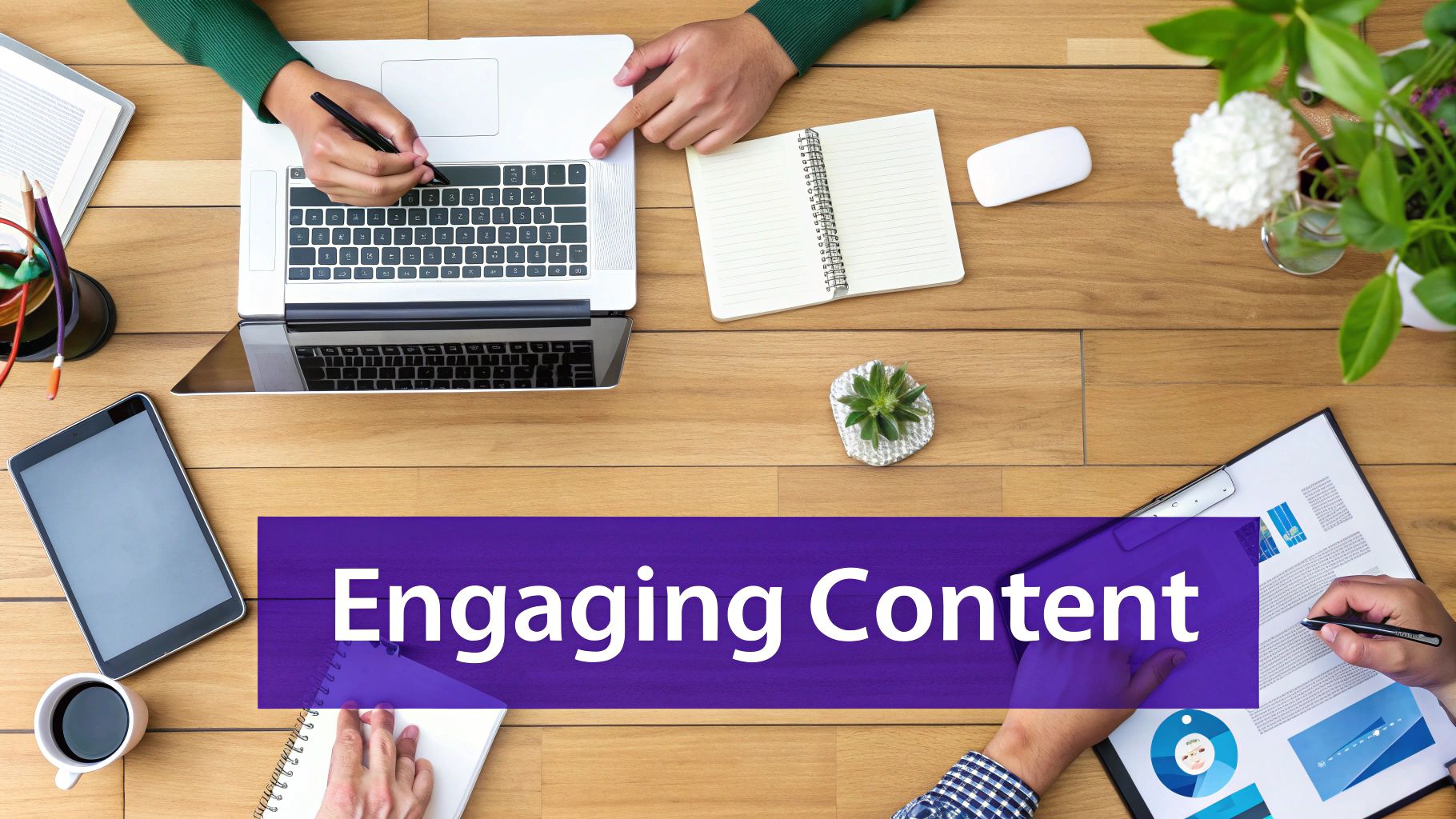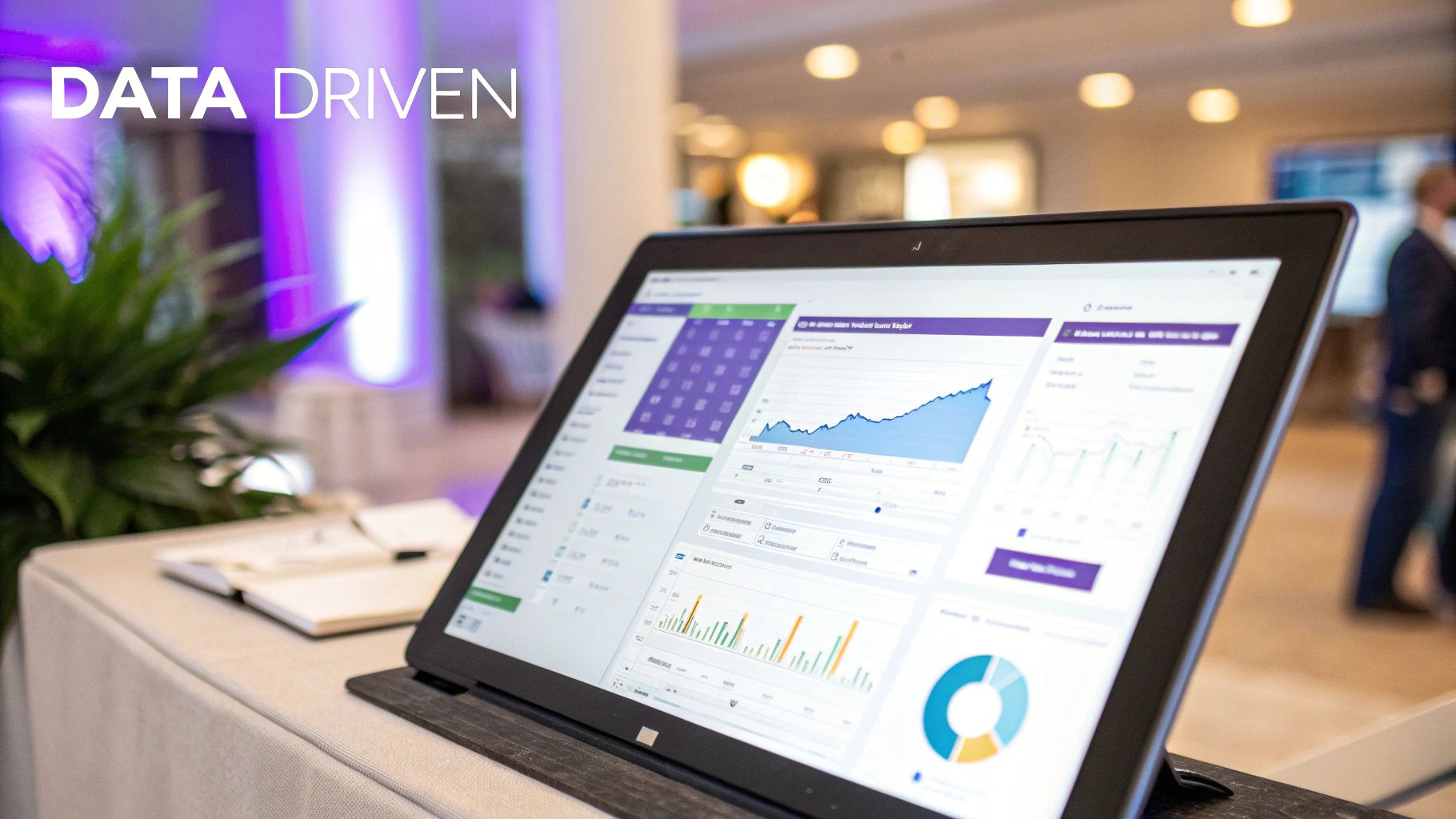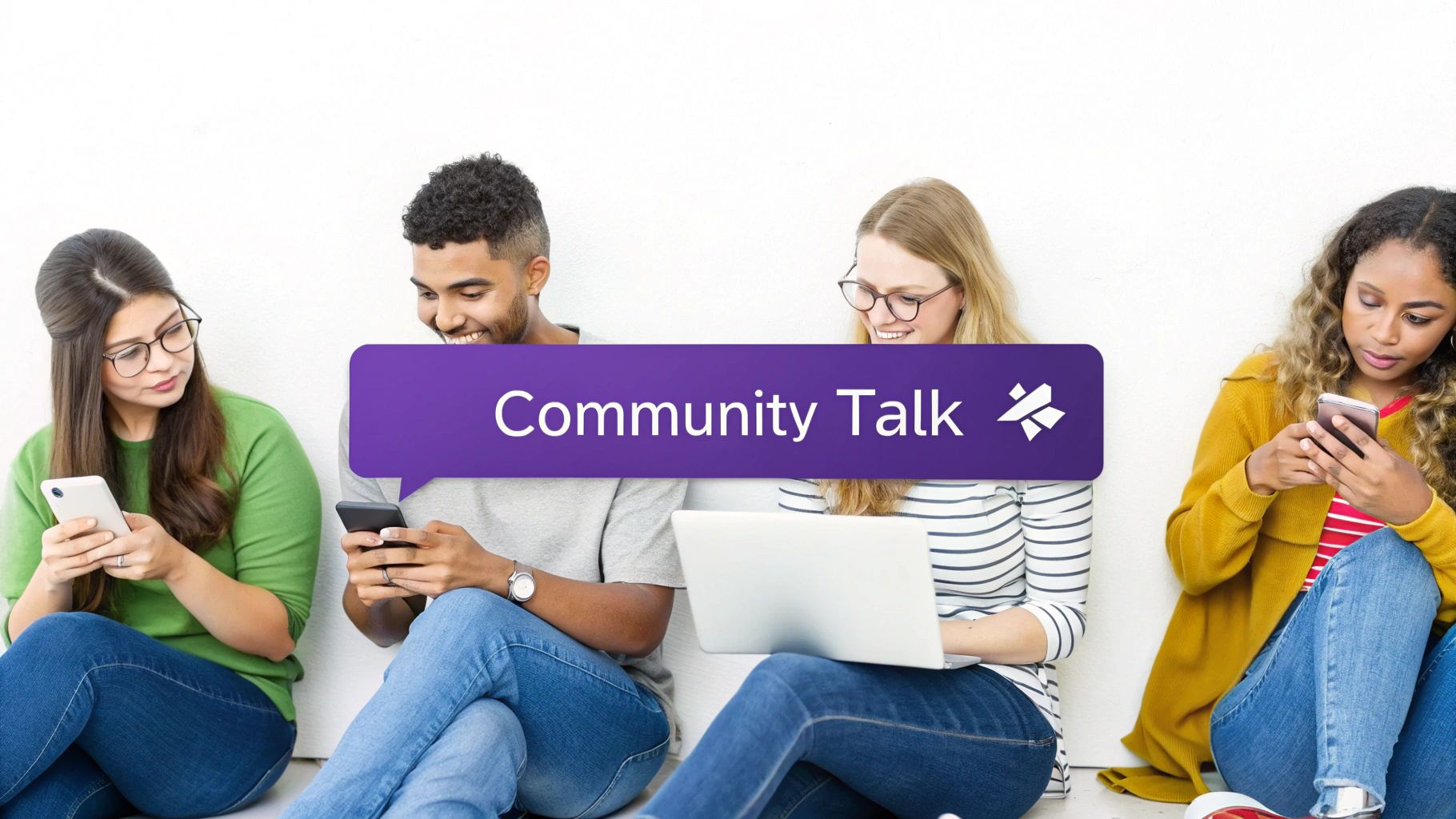How to Improve Social Media Engagement: Top Tips
Discover how to improve social media engagement with proven tips and expert insights to boost your online presence.
Posted by
Navigating Today's Social Media Engagement Landscape

Understanding social media engagement is key to any successful strategy. Think of it like navigating a new city – you need a map. Before diving into tactics, it's crucial to grasp the current state of engagement across various platforms. This means understanding what resonates with audiences, what falls flat, and the reasons behind it.
Understanding the Shifting Engagement Ecosystem
Social media is constantly evolving. Algorithm changes, shifting user preferences, and the emergence of new platforms all contribute to this dynamic environment. Staying up-to-date on platform best practices and audience behavior is more important than ever. What worked last year might not be effective today. For example, short-form video content currently dominates many platforms, often outperforming static images in reach and engagement.
Globally, social media's influence is enormous and continues to expand. As of early 2025, roughly 5.07 billion people, about 94.2% of global internet users, actively use social media each month. This massive user base has grown by 259 million in just a year. This presents a substantial opportunity for brands, but also intensifies the competition for user attention. For more detailed statistics, check out this resource: Smart Insights' social media research.
Realistic Benchmarks and Achievable Goals
One common pitfall is setting unrealistic engagement goals based on outdated data. This can lead to wasted resources and discouragement. Instead, focus on platform-specific benchmarks and understanding your industry's average engagement rates. This approach is crucial for setting achievable targets, allowing you to track progress and adjust your strategy as needed.
Understanding the nuances of each platform's algorithm is also essential. What drives engagement on Instagram might differ significantly from what works on LinkedIn. This is where tools like EndorseFlow can be invaluable. EndorseFlow helps streamline social media management, allowing you to tailor content and posting schedules for optimal performance on each platform. This sets the stage for a more effective engagement strategy.
Platform-Specific Tactics That Actually Work

A successful social media strategy hinges on understanding each platform's unique strengths. This means tailoring your content to resonate with the specific audience and features of each network. A generic approach simply won't deliver the results you're looking for. You need a targeted strategy for each platform.
Understanding how each platform operates and what its users expect is key. Optimizing platform-specific content strategies is crucial, especially on Instagram, a powerhouse with 2 billion monthly active users globally as of early 2025.
Although Instagram's overall engagement rate has dipped by 28% year-over-year to 0.50%, it's still more than three times higher than Facebook's 0.15%. This shows that while engagement is declining, Instagram users remain highly active compared to other platforms. You can find more detailed statistics at SproutSocial's social media statistics.
Tailoring Your Content For Each Platform
Understanding platform nuances is key to success. For example, Instagram thrives on visually appealing content, such as high-quality images and short videos. Using features like Stories, Reels, and interactive stickers can boost engagement.
However, on LinkedIn, the focus shifts to professional networking and industry insights. Long-form articles, thought leadership pieces, and engagement in industry discussions are more effective here.
Mastering Timing and Platform Features
Knowing the best posting times for each platform is also crucial. Each platform has its own peak usage periods. Posting during these times can dramatically increase visibility and engagement.
Using platform-specific features is another smart move. Think Twitter Spaces for live discussions, LinkedIn polls for gathering feedback, or Facebook Groups for building communities. These tools offer direct interaction with your audience, fostering deeper connections and loyalty.
Examples of Effective Platform-Specific Strategies
Let's look at some practical examples. A fashion brand might use Instagram to showcase visually appealing product photos and behind-the-scenes looks at photoshoots. On LinkedIn, they could share company updates, industry trends, and articles about their sustainable manufacturing processes. For tips on optimizing your posting strategy, check out our guide on How to master social media scheduling.
To help you develop a targeted strategy, let's compare engagement rates and content strategies across different platforms:
To understand where to focus your efforts, the following table breaks down average engagement rates and optimal content strategies for several popular social media platforms.
Platform Engagement Rate Comparison: A comparative analysis of average engagement rates across major social media platforms to help guide content distribution strategy.
| Platform | Average Engagement Rate | Best Content Types | Optimal Posting Frequency |
|---|---|---|---|
| 0.50% | High-quality images, short videos, Stories, Reels | Varies by industry, but typically 1-2 times per day | |
| 0.15% | Text, image, and video posts; live videos; stories | 1-2 times per day | |
| 0.034% | Short-form text updates, news, links, images, videos | Several times per day | |
| 0.25% | Long-form articles, industry insights, professional networking updates | 1-2 times per week |
As you can see, visual platforms like Instagram generally have higher engagement rates, but building a presence on platforms geared towards professional networking, like LinkedIn, is crucial for reaching specific demographics. Tailoring your content to suit each platform is essential for maximizing your reach and impact.
Building a Cohesive Brand Voice Across Platforms
While tailoring content is important, maintaining a consistent brand voice is crucial. Your brand's personality should be recognizable regardless of the platform. This requires careful thought about your brand's values, tone, and style.
Consistency builds trust and helps your audience connect with your brand across social media. This cohesive presence strengthens brand recognition and fosters a loyal following. Strategic content calendar planning is vital for maintaining consistent, high-quality, platform-specific content. For more guidance, you might find this helpful: How to create a social media calendar.
Creating Content That Stops the Scroll

Creating engaging social media content isn't just about posting frequently. It's about capturing your audience's attention in the endless stream of information. This means understanding what makes people pause their scrolling and truly connect with your content. What motivates those likes, comments, shares, and genuine interactions? This is where the art of crafting compelling content comes in.
Balancing Content Types for Maximum Impact
Successful social media relies on a strategic blend of educational, entertaining, and promotional content. Think of it as curating a balanced diet for your followers. Too much of one type, and your audience might lose interest. Educational content positions you as a valuable resource, offering helpful tips and relevant insights. Entertaining content keeps things light and shareable, injecting some fun into the mix. Promotional content, while essential for business, should be integrated strategically. The magic lies in finding the right balance to keep your audience engaged and returning for more.
For example, a fitness apparel brand could share workout advice (educational), humorous fitness memes (entertaining), and new product announcements (promotional). The focus should always be on adding value for the audience.
Visuals and Captions That Capture Attention
Visuals play a crucial role in social media. High-quality images and videos are far more likely to stand out in a crowded feed. Invest in visually appealing content that reflects your brand's aesthetic and resonates with your target demographic. Captions are equally important. A well-written caption adds context, sparks conversations, and encourages interaction. They can tell stories, pose questions, or even include calls to action.
A striking image paired with a thoughtful caption is a powerful combination. This dynamic duo creates a compelling hook that draws viewers in and encourages them to engage with your content.
The Power of Storytelling
Storytelling is a powerful way to connect with your audience on a deeper level. Sharing authentic stories that align with your brand's values and mission fosters trust and loyalty. These narratives could highlight customer success stories, offer behind-the-scenes glimpses into your business, or even share challenges you've overcome. By humanizing your brand, storytelling creates an emotional connection with your audience.
Developing a Unique Content Style
Just as a musician develops a signature sound, cultivating a recognizable content style is crucial for distinguishing yourself on social media. This involves establishing a consistent tone of voice, visual aesthetic, and approach to storytelling. Consider how you can visually and textually differentiate your content. A distinct style helps your audience instantly recognize your posts, increasing the likelihood of engagement. For help planning your social media content, Learn more in our article about How to master a social media content calendar.
By combining these elements, you create content that not only appears in feeds but genuinely resonates with your audience, encouraging them to interact, share, and become active members of your online community.
Strategic Promotion That Amplifies Organic Momentum

Paid social media promotion, when executed strategically, can significantly enhance your organic social media engagement. It's not about simply spending money on boosted posts. It's about strategically using paid promotion to ignite overall engagement growth. This section explores how targeted amplification can transform your results, even on a tight budget.
Targeted Amplification: Reaching the Right Audience
One of the most potent aspects of paid promotion is the ability to target specific audience segments. This precision allows you to connect with users genuinely interested in your content, rather than broadly targeting and hoping for engagement. Think of it like focusing a magnifying glass on a specific point to create heat.
By precisely targeting your ideal customers, you dramatically increase the likelihood of meaningful interactions. This targeted approach results in higher click-through rates, more comments, and greater organic reach as engaged users share your content within their networks.
Retargeting: Re-Engaging Warm Prospects
Retargeting is another effective strategy for increasing engagement. This involves reconnecting with users who have previously interacted with your content or website. For example, you could target users who visited a specific product page but didn't complete a purchase.
By gently reminding them of their initial interest, you can re-engage them and guide them further along the sales funnel. This focused approach optimizes your advertising budget by concentrating on users already familiar with your brand. Read also: How to master marketing automation workflows.
Budget Allocation and Content Performance
Strategic budget allocation is crucial for successful paid promotion. Analyze your content performance to pinpoint which types of content thrive with paid support. Some content might perform better organically, while others, like high-performing videos or blog posts, could benefit from a paid boost to reach a broader audience.
Data reveals a strong connection between ad spend and engagement potential. In 2023, U.S. businesses were projected to spend roughly $68 billion on social media advertising. Global spending was estimated to reach $207 billion, accounting for 33% of all digital ad spend. The average click-through rate (CTR) for social media ads was 1.36% in Q2 2023. This translates to approximately 1 in 74 ad impressions resulting in a click, a significant engagement indicator. Find more detailed statistics here: Learn more about social media marketing statistics.
Measuring ROI and Sustainable Momentum
Measuring the return on investment (ROI) of your engagement-focused advertising is essential. This involves tracking key metrics such as website traffic, lead generation, and conversions. Focus on the metrics directly tied to your business objectives. It's not about vanity metrics like likes or followers; it's about understanding how paid promotion contributes to your overall business success.
Finally, consider how to establish sustainable momentum that endures beyond your paid campaigns. The ultimate goal is to use paid promotion as a launchpad for long-term organic growth. By cultivating genuine connections with your audience, you build a loyal following that consistently engages with your content organically. This establishes a self-sustaining cycle of engagement that delivers lasting results.
Building Genuine Community Through Consistent Interaction
True social media success isn't about superficial metrics. It's about fostering a thriving online community around your brand. This means moving beyond one-way broadcasting and embracing genuine two-way conversations with your audience. This section explores how consistent interaction can transform passive followers into active participants and enthusiastic brand advocates.
Encouraging Authentic User-Generated Content
User-generated content (UGC) is incredibly valuable. It's a powerful testament to your brand's impact and resonates with audiences far more than polished marketing materials. However, authentic UGC can't be forced. It needs to be nurtured.
Think of it like gardening. You cultivate the right environment, plant the seeds, and then allow them to grow organically. Running contests, showcasing user posts on your profile, and creating branded hashtags are all excellent ways to encourage sharing and foster a sense of belonging. This allows users to contribute their own unique perspectives to your brand's story.
Moderating Discussions and Maintaining Healthy Conversations
Just like any real-world community, online spaces require active moderation. Establishing clear guidelines and addressing negative comments or spam helps create a safe and inclusive environment for everyone. This fosters respectful dialogue and encourages positive interactions between community members.
Think of yourself as a host at a party. A good host ensures everyone feels welcome and comfortable, leading to a positive experience for all attendees. Similarly, consistent moderation cultivates a positive online space where users feel encouraged to participate and contribute constructively.
Developing Engaging Content Series
Creating content series that naturally spark conversation is a powerful engagement booster. Consider incorporating Q&A sessions, behind-the-scenes glimpses into your business, or recurring themes that invite consistent participation. This builds anticipation and keeps your audience coming back for more.
This approach is similar to how a successful TV show keeps viewers engaged. Each episode leaves them wanting more, cultivating a loyal following eager for the next installment. In the same way, well-crafted content series build an ongoing connection with your audience.
Creating a Distinctive Brand Voice and Response Protocols
A distinct brand voice is crucial for community building. Establishing a consistent tone and style that resonates with your target audience helps build recognition and fosters a sense of connection.
Coupled with a clear brand voice, consistent response protocols are essential. Timely replies to comments and messages demonstrate that you value your audience's input and are actively listening. These seemingly small interactions can significantly strengthen relationships and build trust. EndorseFlow can help create these protocols and automate responses, ensuring prompt interactions with your audience.
Transforming Followers Into Community Members
The ultimate goal is to turn casual followers into committed community members. This involves creating a sense of belonging and shared purpose. When users feel valued and heard, they become more likely to actively participate and even advocate for your brand. This translates to increased engagement and a stronger overall brand presence.
To illustrate how to approach community building based on your brand's size, consider the following table:
Community Building Tactics by Brand Size: Effective community engagement strategies based on follower count and resource availability
| Brand Size | Recommended Tactics | Response Time Goals | Community Management Resources |
|---|---|---|---|
| Small (<10k followers) | Direct engagement with comments, personalized responses, running small contests | Within 24 hours | Founder/owner, dedicated social media manager |
| Medium (10k-100k followers) | Community challenges, user-generated content campaigns, regular Q&A sessions | Within 12 hours | Dedicated social media team, community management tools |
| Large (100k+ followers) | Influencer collaborations, brand ambassador programs, dedicated community forums | Within 2-4 hours | Large social media team, sophisticated community management platforms |
This table offers a practical framework for community building, adapting strategies based on your available resources and audience size. Remember, even small gestures can make a big difference in boosting engagement.
Measuring What Actually Matters Beyond Vanity Metrics
While follower counts and likes offer a glimpse into your social media presence, they don't reveal the full picture. To truly grasp your social media strategy's performance, look beyond these vanity metrics. Focus instead on indicators that directly connect with audience engagement and business impact. This requires shifting from superficial numbers to a deeper understanding of meaningful interaction.
Identifying Key Engagement Metrics
First, pinpoint the metrics aligned with your business goals. If driving website traffic matters most, clicks and link shares become more important than likes. If building brand awareness is the priority, then reach, impressions, and share of voice carry more weight.
For instance, a business focused on lead generation might prioritize click-through rates on website links within their posts. A company building brand awareness might focus on reach and the number of mentions or shares their content receives. Focusing on actionable metrics helps measure content effectiveness and adjust your strategy.
Establishing Baselines and Setting Realistic Goals
After identifying key metrics, establish baseline measurements. Understand your current performance before making changes. This creates a starting point to track progress and assess your efforts.
Next, set realistic growth targets based on platform realities and industry benchmarks. Avoid comparing your performance to accounts with significantly different follower counts or resources. Focus on achievable improvements aligned with your overall marketing strategy.
Competitive Analysis and Actionable Insights
Competitive analysis is crucial for understanding your position within your industry. Analyze competitor engagement metrics to identify their successes and potential opportunities for you to excel.
This isn't about copying strategies, but gaining insights into industry trends and best practices. This information can refine your approach and develop tactics for a competitive edge.
Interpreting Engagement Patterns and Adapting to Change
Regularly analyze engagement patterns to understand what resonates with your audience. Look for trends in content types receiving the most interaction, peak engagement times, and the platforms where your audience is most active.
This data informs content decisions, optimizes posting schedules, and allocates resources effectively. It also enables adaptation to algorithm changes. Understanding audience behavior trends allows you to adjust your approach and maintain strong engagement.
Communicating Social Media Value to Stakeholders
Finally, communicate the value of your social media efforts to stakeholders. Demonstrate the link between your social media activities and tangible business outcomes.
Instead of focusing on vanity metrics, highlight metrics related to revenue generation, lead generation, or brand awareness. By connecting social media engagement to business outcomes, you showcase the value and return on investment (ROI) of your efforts.
Improve your social media management and boost engagement with EndorseFlow. Streamline your social media strategy and drive meaningful results with EndorseFlow.